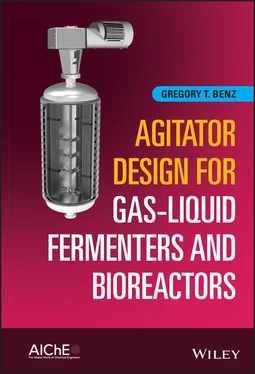There are two causes for this drop. One is that some of the gas is entrained, or held up, in the liquid, causing its apparent density to decrease. Remember, from the power number definition, power draw is directly proportional to fluid density. The other cause is that gas pockets may form along the backside of impellers, streamlining the flow, and reducing drag. For flat‐blade turbines, such as the Rushton, this is the major cause of power draw reduction. For deeply concave impellers, the gas pockets are greatly reduced or even eliminated. Pockets also tend to be smaller on axial flow impellers. We will illustrate these pockets in Chapter 5under each impeller. For now, note that the gassing factor for deeply concave impellers is usually between 0.85 and 1.0, whereas for Rushton impellers, it can be as low as 0.3. Axial flow impellers generally have gassing factors between these ranges.
When gas is dispersed into liquids, it does not rise to the surface instantly. Smaller bubbles take longer to discharge at the surface than larger ones. High power/volume produces smaller bubbles, on average. And the more gas is introduced, the more that will be present in the broth at any given moment. Moreover, as the agitation gets stronger, there is more recirculation of bubbles. All of these things contribute to gas holdup.
From a fluid property point of view, surface tension, ionic strength, presence of solids, presence of a second liquid phase, and viscosity all influence holdup. Holdup may be defined as:
(4.2) 
For a water‐like fluid, the holdup may be estimated as follows, using the MKS system of units:
(4.3) 
The effect of viscosity can be very complex. Sensel et al. [2] suggested the following:
(4.4) 
These equations are approximately valid for holdup fractions of up to 20%, yet some fermenters run at over 40% holdup. Viscosity was tested through 350 cP, but many fermenters operate at a higher viscosity than that. Also, the above equation cannot be used for mixed impeller types and diameters. For best results, an empirically derived holdup expression should be developed for the specific broth in question.
Example of Holdup Calculation
We will use equation 4.3. A fermenter with a working volume of 159 m 3and a tank diameter of 4.11 m has an actual airflow of 0.31 m 3/s, giving us a superficial gas velocity of 3.01E‐2 m/s. The fluid density is 1050 kg/m 3, and the agitator gassed power draw is 158 kW or 158 000 W. Substituting into Eq. (4.3), we get: H = 1.56*(158 000/1050*158) 0.33* (3.01e‐2) 0.67= 0.147.
Now, using equation 4.2, we can estimate the gassed volume. Re‐arranging equation 4.2, we can get:
(4.5) 
Substituting H: (1‐0.147)V g= 0.147*159 m 3or V g= 27.4 m 3. The total gassed volume, V g+ V l, is therefore 186.4 m 3, an increase of 17% over the ungassed volume, or a ratio of 1.17 times the ungassed volume. This may also be simply calculated by saying:
(4.6) 
I am adding this in the hopes it may amuse readers as well as to forewarn them about a potential hazard involving holdup. A project team I led designed a fermentation system for a 250 m 3working volume fermenter (full volume about 350 m 3) that was designed to have up to 1.5 VVM of airflow and was equipped with a 750 kW agitator. The projected holdup based on the working volume was close to 40%, or 100 m 3. During mechanical commissioning, the customer test crew decided to fill the tank with water to the brim and then start it up with 100% airflow and agitation. Luckily, they left the manway open! Within seconds of start‐up, we estimate that about 100 m 3of water, with a whole lot of entrained air, came out of the manway and hit the ceiling, then rained down on structures and people below. Fortunately, there were no injuries, though a few people got very wet. Had there been anyone looking into the manway or even on the catwalk close to the manway, serious injuries, or even a fatality could have occurred. So, test your fermenters at the operating volume, not with a full tank!
Variable Gas Flow Operation
Though some fermenters operate in a continuous mode, most operate in batch or semi‐batch mode, so that it is possible to create lot numbers (in the case of pharmaceutical products) or periodically sterilize and clean to approach aseptic operation. Batch and semi‐batch fermenters typically start out with a limited cell concentration and therefore a relatively low OUR. Although it is usually possible to run constant airflow, this is a wasteful practice, as less air is needed when the biomass concentration is low. Therefore, most fermenters operate with a variable airflow, starting low and increasing as needed, sometimes reducing near the end of the batch.
Airflow affects agitator power draw, as stated earlier. For some impellers, the gassing factor can be as low as 0.3 under peak airflow conditions. For others, it can be much higher. Some are as high as the density reduction factor, which is typically between 0.85 and 1.0. So, what airflow should the impeller system be designed for?
If the impeller system is designed to run ungassed at full shaft speed, it will draw less power at peak airflow conditions, where the most power is needed. Impellers that maintain a high gassing factor are preferred for this reason.
If the impeller system is designed to invest as much motor power as possible at maximum airflow and shaft speed, this is the best design for mass transfer. However, if the gas flow is reduced or eliminated, the impeller system will overload the motor, perhaps severely, unless the shaft speed is reduced. So, again, impellers with a high gassing factor are preferred, as it may even be possible to only slightly oversize the motor to allow ungassed operation.
Most fermenters have some sort of variable speed drive, the most common being variable frequency drives (VFDs). With such drives, it would be possible to design for maximum power at peak airflow and reduce speed as needed to operate at reduced or zero airflow. However, impellers with low gassing factors would have to be reduced further in speed than those with a high gassing factor, particularly considering the fact that VFDs and similar drives operate on a constant torque curve over about a 3 or 4 to 1 speed range, but not at constant power capability. That means the available power is equal to the rated motor power times the ratio of operating speed (or frequency) to full speed at the nominal power supply frequency.
The above points are illustrated in Figure 4.4.
Figure 4.4shows a typical motor curve when operated on a VFD control. It is constant torque (% Hp = % speed) for a 4:1 ratio and variable torque (% Hp proportional to speed squared) below that. Superimposed on that curve are two operating points. Being compared are a high gassing factor impeller and a low gassing factor impeller. The high gassing factor impeller has a gassing factor of 0.85 at 1 VVM airflow and can run at 90% of full speed ungassed. The low gassing factor impeller has a gassing factor of 0.31 at 1 VVM and must have its speed reduced to 55% of full speed in order to avoid overloading the motor ungassed. This means it is impossible for the low gassing factor impeller to invest as much power at reduced airflow as would be possible with the high gassing factor impeller.
Читать дальше

















